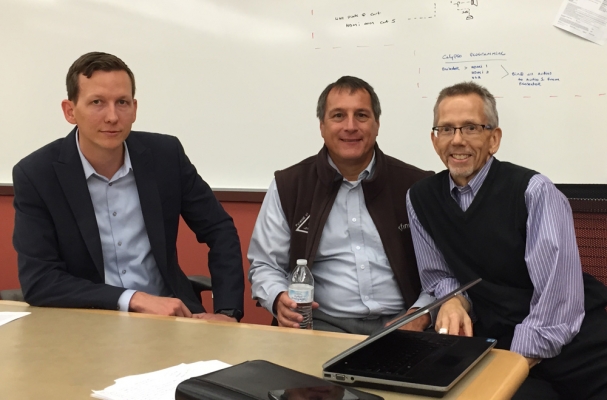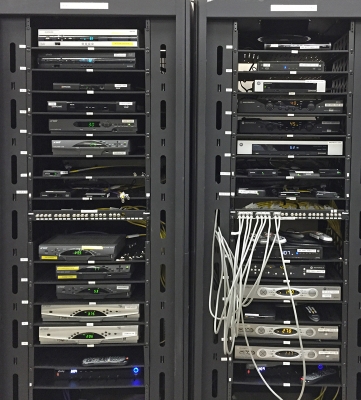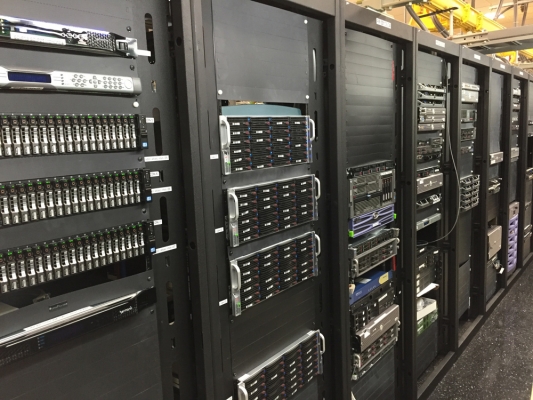 If you like, want or need ever-faster internet connection speeds, Comcast has delivered them for you this week. It’s also fairly certain we’ll see continued speed increases this year as the cable industry rolls out a new standard and Comcast in Minnesota delivers it.
If you like, want or need ever-faster internet connection speeds, Comcast has delivered them for you this week. It’s also fairly certain we’ll see continued speed increases this year as the cable industry rolls out a new standard and Comcast in Minnesota delivers it.
The company just announced a significant internet speed increase in the markets they serve in Minnesota by doubling their 25 megabits per second (Mbps) tier of service to 50Mbps; their former 50Mbps tier to 105Mbps; and their 105Mbps to 150Mbps. As part of their launch, Minnov8 was invited to tour their Roseville data center facility and ask questions about this announcement and see their infrastructure, how they network monitor and manage the volume of subscribers and the data consumed, and a bit about their future plans.

Twin Cities Region leaders (l-r): Troy Lupe, VP of Field Operations for the Twin Cities Region; Patrick Galazen, Manager of Network Engineering; Dave Nyberg, Sr. Manager – Media Relations
Comcast’s senior manager of media relations, Dave Nyberg, met me at the door in their primary Roseville data center when I arrived and a team of five was awaiting my arrival (pictured at right with the exception of Emmett Coleman, VP of External Affairs, who had to leave early to get on a conference call).
We talked briefly and then started off with a tour of their data center at this cable “head-end” facility. What struck me from the outset was that this was a data center…not the type of traditional cable TV head-end I’d toured during my days working with Pioneer’s cable and new media group in Chicago back in the 1980s. In those days the world was TV-centric and so were cable companies. Today it’s all about data, and lots of it, and Comcast is forever changed as a result.

These two racks will give you a glimpse in to the support these Twin Cities data centers must provide for legacy set-top boxes and DVRs.
As Patrick Galazen walked me through the racks of servers and explained what was in each area, it was clear how they are poised to be in front of the trend of everything going digital. As a result of that trend the miniaturization of data center servers, switches, drives and other components have made it possible for Comcast to deliver substantially more capability in an ever-smaller space. They will need more space over time, especially since the migration from real-time video content to video-on-demand (VOD), streaming and enhanced services like Comcast’s new Xfinity X1 interactive platform, means the demand on these data centers (and on guys like Galazen) is going to continue to grow rapidly.
This means Comcast Twin Cities—an organization with three of these data centers (the other two are in Eden Prairie and Eagan)—will have to continue to invest, enhance, manage and extend the types of services they can offer. Make no mistake about this being “just another data center” if you’ve toured another one in the past, or that Comcast as an organization can afford any network outages. I know that I go ballistic when my Comcast internet has gone down but, fortunately due to the work of guys like Galazen and crew, that’s only happened a handful of times in 15 years!

One of several rack rows that show the size reduction in various components which has resulted in increased efficiencies and more available rack space for future expansion.
The future holds alot of promise for anyone who is a current Comcast customer in the Twin Cities. It was impressive to learn more about (and see) their investments in fiber-to-coax; increases in faster solid state drive (SSD) based architectures; failover, backup, network operations management and more. In fact, we stopped by one area where I got a close look at a geo-location management software that can pinpoint an outage, narrow it down to a specific in-premise location, see if that outage is dependent on some other network node or layer, and then they can quickly fix it. Probably why their internet and TV outages are so rare since they’re on top of any trouble that may arise.
What I didn’t expect was the undercurrent to everything that was discussed on the tour and during our talks afterward: That their sole focus is to efficiently deliver the TV, phone and internet services we expect to get the instant we click a button on our TV remotes, pick up a phone, or when we click or touch a link in a web browser.
One of the technologies to watch (and they mentioned we’ll see some early rollouts here in Minnesota this year) is one that will deliver even FASTER speeds going forward: DOCSIS 3.1, a new cable technology currently installed and being tested.
DOCSIS 3.1 will support up to 10 Gbps downstream and up to 1 Gbps upstream network capacity. As we see other companies rollout gigabit (or multi-gigabit) speeds with fiber deployment (e.g., Google Fiber, USInternet and CenturyLink), it’s important to remember that delivering fiber-to-the-home by installing premise equipment and pulling fiber optic cable is so expensive that those rollouts are quite slow in coming. Still, we all know that competition drives incremental (and sometimes monumental) innovation and, with our market seeing fiber-based options increasingly available, Comcast has no choice but to drive forward and keep ahead of the competition curve.
As someone who has been concerned (and quite vocal) in the past about the lack of high speed options for internet access here in the Twin Cities, as the world shifts more and more of its media, information, learning, and knowledge consumption online, the competition will increase and that’s a good thing. But Comcast is an a unique position and their competitive advantages don’t rely solely on their coax, data centers and history as an internet service provider. They have relationships with media companies, peering agreements in place, long experience with delivering both TV and internet service, along with the people I met this week making it happen in the field.
I, for one, am excited to go faster!
![]()
COMCAST INCREASES INTERNET SPEEDS FOR TWIN CITIES AREA CUSTOMERS
Speeds To Be Doubled on Most Popular Tiers at No Additional Cost to Customers,
Just in Time for Back-to-School
ST. PAUL, MN – August 25, 2015 – Comcast today announced it will increase speeds for most Xfinity Internet customers in the company’s Twin Cities, Greater Minnesota and Western Wisconsin service area on Thursday, August 27. These speed increases are being delivered to customers at no additional cost.
Comcast will increase the speeds of its three most popular Xfinity Internet tiers: “Performance” will deliver speeds up to 50 Mbps, up from 25 Mbps; “Blast” will more than double to 105 Mbps, up from 50 Mbps; and “Extreme 105” will increase to 150 Mbps. The speed increases will be available for all Xfinity Internet customers who currently subscribe to these tiers.
“We continue to deliver the fastest speeds to the most homes to provide our customers a terrific online experience,” said Jeff Freyer, Region Vice President, Comcast-Twin Cities Region. “Consumers want Internet service that delivers consistent speed, rock-solid reliability and great value, and we’re proud to meet that demand as the nation’s fastest Internet Service Provider according to Speedtest.net.” Freyer added, “Comcast also provides the fastest in-home WiFi so everyone can get online at the same time, which is especially important as families get ready to go back to school.”
“We applaud Comcast’s commitment to increase Internet speeds at no additional cost for their customers across its service area,” said Margaret Anderson-Kelliher, President and CEO of the Minnesota High Tech Association and Chair of the Minnesota State Broadband Task Force. “These faster speeds are a big leap forward for broadband in the state and will strengthen our future and our position as a great place to live, work and play.”
Ramsey County Commissioner Blake Huffman discussed the benefits of faster Internet speeds for the region. “In today’s world, being connected to the Internet isn’t a luxury, it’s a necessity. The strength of our communities depends on a vibrant infrastructure, and this investment by Comcast is a perfect example of effective public-private partnerships that benefit everyone.”
Customers can take advantage of this speed increase beginning Thursday morning by ‘power-cycling’ their cable modem with the reset button on the device, or by unplugging the modem power cord from the electrical outlet, waiting a few seconds and then plugging it back into the outlet. Customers can also reset their modem remotely by using the Xfinity My Account app, available for both Apple and Android devices, or by going online at www.comcast.com/myaccount.
Freyer commented on the available options for activating the new speeds. “The use of the Xfinity My Account app is one more example of how we’re working hard to transform the customer experience by giving subscribers more control over their service, and adding even greater value by increasing speeds and delivering their products anytime, anywhere and on any device.”
In addition, Comcast representatives will be on hand during the 2015 Minnesota State Fair at the Fan Central exhibit at Dan Patch Ave. and Underwood St. to assist customers with the speed increase. Customers can also stop by Comcast’s Xfinity Store locations across the Twin Cities and New Ulm. (See below for Store locations.)
Comcast also recently announced the doubling of speeds for Internet Essentials, the company’s innovative program designed to bring Internet access to low income families across the nation.
COMCAST XFINITY STORE LOCATIONS
ABOUT COMCAST CORPORATION
Comcast Corporation (Nasdaq: CMCSA, CMCSK) is a global media and technology company with two primary businesses, Comcast Cable and NBCUniversal. Comcast Cable is one of the nation’s largest video, high-speed Internet and phone providers to residential customers under the XFINITY brand and also provides these services to businesses. NBCUniversal operates news, entertainment and sports cable networks, the NBC and Telemundo broadcast networks, television production operations, television station groups, Universal Pictures and Universal Parks and Resorts. Visit www.comcastcorporation.com for more information.
Contact:
Dave Nyberg, Sr. Manager – Media Relations
Comcast Twin Cities
651-493-5291
Dave_nyberg@cable.comcast.com